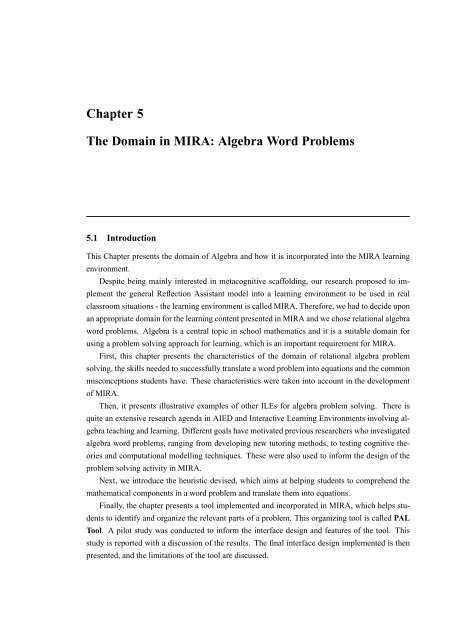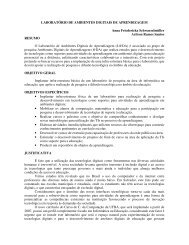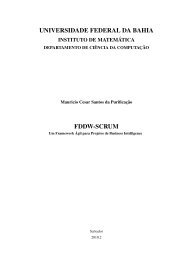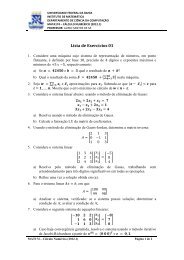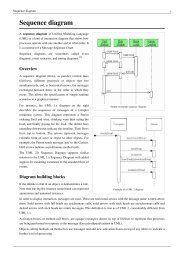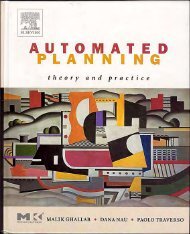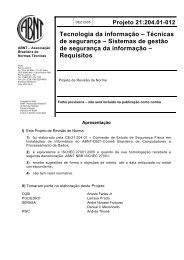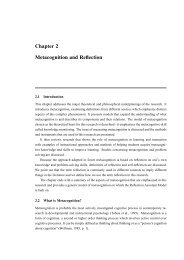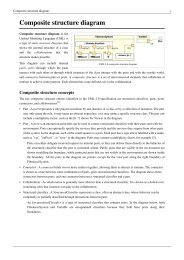Chapter 5 The Domain in MIRA: Algebra Word Problems
Chapter 5 The Domain in MIRA: Algebra Word Problems
Chapter 5 The Domain in MIRA: Algebra Word Problems
You also want an ePaper? Increase the reach of your titles
YUMPU automatically turns print PDFs into web optimized ePapers that Google loves.
<strong>Chapter</strong> 5<strong>The</strong> <strong>Doma<strong>in</strong></strong> <strong>in</strong> <strong>MIRA</strong>: <strong>Algebra</strong> <strong>Word</strong> <strong>Problems</strong>5.1 IntroductionThis <strong>Chapter</strong> presents the doma<strong>in</strong> of <strong>Algebra</strong> and how it is <strong>in</strong>corporated <strong>in</strong>to the <strong>MIRA</strong> learn<strong>in</strong>genvironment.Despite be<strong>in</strong>g ma<strong>in</strong>ly <strong>in</strong>terested <strong>in</strong> metacognitive scaffold<strong>in</strong>g, our research proposed to implementthe general Reflection Assistant model <strong>in</strong>to a learn<strong>in</strong>g environment to be used <strong>in</strong> realclassroom situations - the learn<strong>in</strong>g environment is called <strong>MIRA</strong>. <strong>The</strong>refore, we had to decide uponan appropriate doma<strong>in</strong> for the learn<strong>in</strong>g content presented <strong>in</strong> <strong>MIRA</strong> and we chose relational algebraword problems. <strong>Algebra</strong> is a central topic <strong>in</strong> school mathematics and it is a suitable doma<strong>in</strong> forus<strong>in</strong>g a problem solv<strong>in</strong>g approach for learn<strong>in</strong>g, which is an important requirement for <strong>MIRA</strong>.First, this chapter presents the characteristics of the doma<strong>in</strong> of relational algebra problemsolv<strong>in</strong>g, the skills needed to successfully translate a word problem <strong>in</strong>to equations and the commonmisconceptions students have. <strong>The</strong>se characteristics were taken <strong>in</strong>to account <strong>in</strong> the developmentof <strong>MIRA</strong>.<strong>The</strong>n, it presents illustrative examples of other ILEs for algebra problem solv<strong>in</strong>g. <strong>The</strong>re isquite an extensive research agenda <strong>in</strong> AIED and Interactive Learn<strong>in</strong>g Environments <strong>in</strong>volv<strong>in</strong>g algebrateach<strong>in</strong>g and learn<strong>in</strong>g. Different goals have motivated previous researchers who <strong>in</strong>vestigatedalgebra word problems, rang<strong>in</strong>g from develop<strong>in</strong>g new tutor<strong>in</strong>g methods, to test<strong>in</strong>g cognitive theoriesand computational modell<strong>in</strong>g techniques. <strong>The</strong>se were also used to <strong>in</strong>form the design of theproblem solv<strong>in</strong>g activity <strong>in</strong> <strong>MIRA</strong>.Next, we <strong>in</strong>troduce the heuristic devised, which aims at help<strong>in</strong>g students to comprehend themathematical components <strong>in</strong> a word problem and translate them <strong>in</strong>to equations.F<strong>in</strong>ally, the chapter presents a tool implemented and <strong>in</strong>corporated <strong>in</strong> <strong>MIRA</strong>, which helps studentsto identify and organize the relevant parts of a problem. This organiz<strong>in</strong>g tool is called PALTool. A pilot study was conducted to <strong>in</strong>form the <strong>in</strong>terface design and features of the tool. Thisstudy is reported with a discussion of the results. <strong>The</strong> f<strong>in</strong>al <strong>in</strong>terface design implemented is thenpresented, and the limitations of the tool are discussed.
<strong>Chapter</strong> 5. <strong>The</strong> <strong>Doma<strong>in</strong></strong> <strong>in</strong> <strong>MIRA</strong>: <strong>Algebra</strong> <strong>Word</strong> <strong>Problems</strong> 845.2 Reasons for Choos<strong>in</strong>g the <strong>Doma<strong>in</strong></strong> of <strong>Algebra</strong>It was desirable to choose a doma<strong>in</strong> where the problem solv<strong>in</strong>g activity is commonly used as anapproach for teach<strong>in</strong>g and learn<strong>in</strong>g. <strong>The</strong> reasons for choos<strong>in</strong>g <strong>Algebra</strong> as the topic to be taughtwith<strong>in</strong> <strong>MIRA</strong> were twofold:i. <strong>Algebra</strong> is an important subject <strong>in</strong> the Mathematics Curriculum.<strong>The</strong> National Council of Teachers of Mathematics (NCTM), which is an <strong>in</strong>ternational professionalorganization committed to excellence <strong>in</strong> mathematics teach<strong>in</strong>g and learn<strong>in</strong>g, calls for an <strong>in</strong>creasedfocus on problem solv<strong>in</strong>g <strong>in</strong> the K-12 mathematics curriculum and suggests that algebra shouldplay an especially important role for students <strong>in</strong> the middle and high school grades. NCTM recommends<strong>in</strong>creased attention to the use of real-world problems, use of computer utilities, andmathematical communication.ii. <strong>Algebra</strong> problem solv<strong>in</strong>g <strong>in</strong>volves a wide range of cognitive skills, which creates a suitableenvironment for develop<strong>in</strong>g metacognition.Accord<strong>in</strong>g to the Pr<strong>in</strong>ciples and Standards for School Mathematics (NCTM, 2000) a good algebraproblem solver needs to master a range of skills that <strong>in</strong>cludes, amongst others (<strong>Chapter</strong> 6, p.222):• Understand relationships, be<strong>in</strong>g able to relate and compare different forms of representationfor a relationship.• Represent and analyse mathematical situations and structures us<strong>in</strong>g algebraic symbols. Inorder to do this, students need to develop a conceptual understand<strong>in</strong>g of different uses ofvariables, to use symbolic algebra to represent situations and to solve problems, and to recognizeand generate equivalent forms for simple algebraic expressions and l<strong>in</strong>ear equations.• Use mathematical models to represent and understand quantitative relationships. Studentsneed to model and solve contextualized problems us<strong>in</strong>g various representations, such asgraphs, tables, and equations.5.3 Relational <strong>Algebra</strong> <strong>Word</strong> <strong>Problems</strong>An algebraic word problem consists of one or more sentences hav<strong>in</strong>g some known or unknownvalues with underly<strong>in</strong>g algebraic equations (Aziz et al., 1995). <strong>The</strong> problems present a situationor a story, where one needs to understand the elements that make up the situation to generate amathematical model to represent it. <strong>The</strong> model consists of one or more equations; solv<strong>in</strong>g theequations yields numerical values that solve the problem. A relational algebra word problemis the one with relational propositions that connect the various elements presented <strong>in</strong> the story.<strong>The</strong> problem presented below is a typical example of a relational algebra word problem and thesentences <strong>in</strong> bold are examples of relational statements.In April, Jill planted 40 roses <strong>in</strong> her yard. <strong>The</strong>n <strong>in</strong> May, she decides she needed moreflowers and she planted some tulips and some poppies. She planted twice as manytulips as she had planted roses and one fourth as many poppies as tulips. How manyflowers had she planted all together?5.3.1 <strong>The</strong> process of solv<strong>in</strong>g algebra word problemsResearchers on maths problem solv<strong>in</strong>g divide the activity of solv<strong>in</strong>g word problems <strong>in</strong>to two stagesthat comprise dist<strong>in</strong>ct cognitive processes (Mayer, 1999; Whimbey and Lochhead, 1999): Problem
<strong>Chapter</strong> 5. <strong>The</strong> <strong>Doma<strong>in</strong></strong> <strong>in</strong> <strong>MIRA</strong>: <strong>Algebra</strong> <strong>Word</strong> <strong>Problems</strong> 85Representation and Problem Solution. Solvers may iterate between these two stages.Each stage is composed of specific activities, which use dist<strong>in</strong>ctive skills and knowledge. Figure5.1 shows the stages and knowledge <strong>in</strong>volved .Figure 5.1: Conceptual stages of algebra problem solv<strong>in</strong>g accord<strong>in</strong>g to Mayer (1999).Stage 1: Problem RepresentationAccord<strong>in</strong>g to Mayer (1999) this stage is composed of two process: translation and <strong>in</strong>tegration.<strong>The</strong>se processes encompass the transformation of algebra word problems <strong>in</strong>to a system of equations.In the literature there are some variations <strong>in</strong> the terms used. Heffernan (2001) uses the termsymbolization to denote the translation process; yet, Whimbey and Lochhead (1999) use translationto <strong>in</strong>dicate both the translation and <strong>in</strong>tegration processes. Similarly, we will adopt the wordtranslation to signify both sub-processes of the Problem Representation stage.<strong>The</strong> knowledge and skills necessary to master the stage of Problem Representation are threefold:• <strong>The</strong> learner has to be able to translate each statement of the problem <strong>in</strong>to some <strong>in</strong>ternalrepresentation <strong>in</strong> memory. This process requires that the student understands the sentencesused to express the problem situation (i.e., the English sentences). It implies that the studentneeds l<strong>in</strong>guistic knowledge.• <strong>The</strong> learner also needs factual knowledge. This means that the problem solver needs someknowledge related to the situation. For example, know<strong>in</strong>g that one hour has 60 m<strong>in</strong>utes.In some cases this factual knowledge is more specific conceptual knowledge. For example,know<strong>in</strong>g that all sides of a square are equal <strong>in</strong> length is more than observational knowledge.It is knowledge of a specific mathematical concept.• In order to build an accurate mathematical representation of the story problem the learnerneeds to <strong>in</strong>tegrate the <strong>in</strong>formation <strong>in</strong> the problem <strong>in</strong> a coherent way. So, she needs to understandhow the statements <strong>in</strong> the problem fit together and to have knowledge of problemtypes (i.e., schematic knowledge).Stage 2: Problem SolutionThis stage <strong>in</strong>volves break<strong>in</strong>g down the problem representation devised <strong>in</strong> the previous stage to depicta numeric solution, and check<strong>in</strong>g this solution aga<strong>in</strong>st the orig<strong>in</strong>al statement. <strong>The</strong> learner has
<strong>Chapter</strong> 5. <strong>The</strong> <strong>Doma<strong>in</strong></strong> <strong>in</strong> <strong>MIRA</strong>: <strong>Algebra</strong> <strong>Word</strong> <strong>Problems</strong> 86to deploy algebraic and arithmetical rules and a wide range of mathematical skills, such as understand<strong>in</strong>gof variable, equality, and symbol manipulation (for example: substitution, simplification,etc.).5.3.2 <strong>The</strong> ma<strong>in</strong> misconceptions and difficultiesPrevious research <strong>in</strong>vestigated the ma<strong>in</strong> misconceptions students have regard<strong>in</strong>g algebra problemsand po<strong>in</strong>ted out the translation stage or sub-processes <strong>in</strong> the translation stage as the source formost of them (H<strong>in</strong>sley et al., 1977; Heffernan and Koed<strong>in</strong>ger, 1998; Mayer, 1999; Whimbey andLochhead, 1999). Even when students master the basic operations and can manipulate equations,they have problems <strong>in</strong> creat<strong>in</strong>g the equations and understand<strong>in</strong>g what they have to do and whythey are do<strong>in</strong>g it (H<strong>in</strong>sley et al., 1977; Derry and Hawkes, 1993).Heffernan (2001) argues that the ability to take a problem situation and formulate a mathematicalmodel is the s<strong>in</strong>gle most important skill needed to succeed <strong>in</strong> algebra problem solv<strong>in</strong>g:“Even if a student has access to a spreadsheet or graph<strong>in</strong>g calculator, the student willstill need to be able to translate a problem <strong>in</strong>to the language of mathematics (i.e., analgebraic expression)” (Heffernan, 2001, p. 3).Derry and Hawkes (1993) conducted research with 244 college students and 81 7 th graders toobserve them solv<strong>in</strong>g algebraic word problems. <strong>The</strong>y found that virtually all of them were able tosolve simple problems, such as ones with a s<strong>in</strong>gle schema 1 <strong>in</strong> it, <strong>in</strong>dicat<strong>in</strong>g basic understand<strong>in</strong>gof algebraic concepts. However, the students experienced <strong>in</strong>creas<strong>in</strong>gly greater difficulty as thecomplexity of the problems or the number of steps to reach the solution <strong>in</strong>creased. <strong>The</strong>y concludedthat even among college students there is great difficulty <strong>in</strong> solv<strong>in</strong>g complex, multistep algebraproblems. <strong>The</strong>y believe that the nature of the difficulties exhibited by the participants <strong>in</strong> theirexperiments is related to misconceptions <strong>in</strong> comprehension of multiple relational schemas to createproblem representations. In their op<strong>in</strong>ion, metacognitive knowledge is what enables some students(and not others) to build complex representations and devise solutions for difficult problems. <strong>The</strong>yhighlight plann<strong>in</strong>g and monitor<strong>in</strong>g as important metacognitive abilities for this purpose.In our research we focus exclusively on students’ abilities to translate algebra word problems<strong>in</strong>to equations because we believe that this stage is the most suitable for experiment<strong>in</strong>g withmetacognitive <strong>in</strong>struction. Thus, at the doma<strong>in</strong> level, <strong>MIRA</strong> adopts an <strong>in</strong>structional method and<strong>in</strong>cludes learn<strong>in</strong>g resources specifically built to help students <strong>in</strong> the translation of verbal representations<strong>in</strong>to algebraic representations.5.4 <strong>Algebra</strong> Problem Solv<strong>in</strong>g <strong>in</strong> ILEs<strong>The</strong>re has been great <strong>in</strong>terest <strong>in</strong> the doma<strong>in</strong> of algebra <strong>in</strong> AIED research community. One motivationseems to be the degree of difficulty students have <strong>in</strong> master<strong>in</strong>g this doma<strong>in</strong>. Some researcherscharacterize algebra word problems as an enigmatic doma<strong>in</strong> (Koed<strong>in</strong>ger and Anderson, 1993); i.e,part of a class of doma<strong>in</strong>s that students f<strong>in</strong>d particularly mysterious such that even when wellmotivatedthey have difficulty (another example of such doma<strong>in</strong> is geometry proofs).1 Derry and Hawkes use the term “schema” to refer to mental abstractions that allow set-relationship patterns <strong>in</strong>problem situations to be recognized and that <strong>in</strong>dicate actions appropriate for those patterns (Derry and Hawkes, 1993).
<strong>Chapter</strong> 5. <strong>The</strong> <strong>Doma<strong>in</strong></strong> <strong>in</strong> <strong>MIRA</strong>: <strong>Algebra</strong> <strong>Word</strong> <strong>Problems</strong> 87Some projects focused on the problem solution stage, present<strong>in</strong>g equations and tra<strong>in</strong><strong>in</strong>g skillssuch as symbol manipulation and simplifications. <strong>Algebra</strong>land (Brown, 1985) is an early example.As presented <strong>in</strong> <strong>Chapter</strong> 3 this system exhibit equations <strong>in</strong> a graphical form and has a menu witha choice of operations to simplify the equations.Other projects <strong>in</strong>volved both stages: problem representation and problem solution. <strong>The</strong> mostextensive work <strong>in</strong> this direction is from Anderson’s group at the Carnegie Mellon University with<strong>The</strong> Carnegie Learn<strong>in</strong>g Tutors.In the early 1990s, the Pittsburgh Advanced Cognitive Tutor(PACT) Center at Carnegie Mellon University developed their first <strong>in</strong>telligent algebra word problemtutor, <strong>in</strong>itially known as the Pump <strong>Algebra</strong> Tutor (PAT) (Koed<strong>in</strong>ger et al., 1997). New, ref<strong>in</strong>edversions, named <strong>Algebra</strong> I Cognitive Tutor and <strong>Algebra</strong> II Cognitive Tutor, were built and nowthey are marketed under the name “Cognitive Tutor”.<strong>The</strong> algebra tutors were constructed around a cognitive model that reflects the ACT-R theory.This theory considers that problem solv<strong>in</strong>g skills can be modelled as a set of <strong>in</strong>dependent productionrules. <strong>The</strong> cognitive model enables the tutor to trace the student’s solution path through acomplex problem solv<strong>in</strong>g space, provid<strong>in</strong>g feedback on each problem solv<strong>in</strong>g action and adviceon problem solv<strong>in</strong>g as needed (Corbett et al., 2000). So, the Cognitive Tutor keeps track of thestudents’ progress, both for each problem and across problems <strong>in</strong> a lesson and chooses problemsbased on the students’ strengths and weaknesses. <strong>The</strong> Tutor controls the advance to a next lesson,and this happens only when the student reaches mastery level <strong>in</strong> all skill areas. <strong>The</strong>y also supportreason<strong>in</strong>g among multiple representations: tables, graphs, symbolic expressions, and naturallanguage. Various versions of the Cognitive Tutor have been used by school children <strong>in</strong> USA.A more recent and <strong>in</strong>terest<strong>in</strong>g project from the Carnegie Group is Ms. L<strong>in</strong>dquist (Heffernan,2001). It differs from the other tutors, because it focuses essentially on the problem representationstage, help<strong>in</strong>g children to build algebraic expressions from the textual description of problems.<strong>The</strong>refore, it does not addresses the teach<strong>in</strong>g and learn<strong>in</strong>g of many algebra skills, like graph<strong>in</strong>gand equation solv<strong>in</strong>g. Instead it concentrates on develop<strong>in</strong>g <strong>in</strong> the student a repertoire of strategiesfor the translation of problems <strong>in</strong>to expressions.Other examples that focus more on the translation stage are the Heron-WATGRAF (Reusser,1993) and TAPS (Derry and Hawkes, 1993). We have already commented on them <strong>in</strong> <strong>Chapter</strong> 3.Both provide a graphical tool for organiz<strong>in</strong>g the components of the problem <strong>in</strong> a tree that l<strong>in</strong>ksthem and makes the relations and operations explicit. Heron also uses a glossary with wordspresented <strong>in</strong> the problems to help with the l<strong>in</strong>guistic and factual knowledge.<strong>The</strong> TAPS project <strong>in</strong>volved an important analysis of the k<strong>in</strong>ds of errors students typically makewhile solv<strong>in</strong>g algebra word problems. Eleven general categories of deviation errors were def<strong>in</strong>ed,and further divided <strong>in</strong>to smaller subcategories. <strong>The</strong> ma<strong>in</strong> categories are summarised below (Derryand Hawkes, 1993, p.118, 119):1. bad value assignments, which can be (among others) due to a transfer mistake (copy<strong>in</strong>gwrong values from the problem description to the solution);2. bad labels to components of the problem, what may signify that students overlook importantdetails or overgeneralize the <strong>in</strong>formation provided <strong>in</strong> the text;3. bad schema; i.e., students construct schemas that are not <strong>in</strong> the current solution path;4. arithmetic errors: wrong operator or comput<strong>in</strong>g errors;
<strong>Chapter</strong> 5. <strong>The</strong> <strong>Doma<strong>in</strong></strong> <strong>in</strong> <strong>MIRA</strong>: <strong>Algebra</strong> <strong>Word</strong> <strong>Problems</strong> 885. omit errors: omit steps or branch of solution;6. isolated bits presented as solution;7. hesitancy, with long idle period with no action;8. wild goose chase with the connection of three of more bad schemas as a solution strategy;9. given up; i.e., students quit or present an answer before complet<strong>in</strong>g a solution strategy;10. unnecessary strategy shift, abandon<strong>in</strong>g promis<strong>in</strong>g path of solution;11. time expires.<strong>The</strong> prototype of TAPS has the capability of recogniz<strong>in</strong>g and <strong>in</strong>terpret<strong>in</strong>g some of these errors,us<strong>in</strong>g a pattern-match<strong>in</strong>g algorithm based on a fuzzy logic technique. Unfortunately, a tutor<strong>in</strong>gand remedial help was not implemented <strong>in</strong> TAPS.Another tutor<strong>in</strong>g system, also called TAPS (Aziz et al., 1995), focuses on misconceptionsrelated to the reversal error (an error often observed <strong>in</strong> expressions like “At this university thereare six times as many students as professors”, where many students answer 6S=P <strong>in</strong>stead of S=6P).A different approach was adopted by the ANIMATE system (Nathan et al., 1992). ANIMATEis a tool students can use to describe equations for word problems, which can then be “animated”.<strong>The</strong> system does not tell the students when they make a mistake; <strong>in</strong>stead, the student observes thebehaviour of the animation to figure out what is wrong.All these projets made some k<strong>in</strong>d of contribution to a better understand<strong>in</strong>g of problem solv<strong>in</strong>gstrategies, students’ misconceptions, and possible ways of foster<strong>in</strong>g the learn<strong>in</strong>g process <strong>in</strong> thisdoma<strong>in</strong>.5.5 Help<strong>in</strong>g to Translate <strong>Problems</strong> <strong>in</strong>to EquationsPolya’s work sheds light <strong>in</strong>to the approach we have adopted for help<strong>in</strong>g students translate algebraproblems. We have envisioned an heuristic that follows Polya’s pr<strong>in</strong>ciples (Polya, 1945) for thetypes of problems we are us<strong>in</strong>g.Our heuristic <strong>in</strong>volves the identification and understand<strong>in</strong>g of the ma<strong>in</strong> elements of algebraword problems: givens, goals, unknowns, and relations. We believe that a declarative understand<strong>in</strong>gof these elements can be a powerful resource lead<strong>in</strong>g to a full understand<strong>in</strong>g of the problem.It enables the organization of the problem <strong>in</strong>to a format to which the student can apply somestrategies <strong>in</strong> order to successfully translate the problem <strong>in</strong>to equations.Below we def<strong>in</strong>e the elements and the heuristic developed. We use the follow<strong>in</strong>g relationalword problem to give a practical example along the explanations:Paul is forty years old. He has two sons, Mat and Kev<strong>in</strong>, and one daughter, Emily.Mat is one quarter of Paul’s age. Kev<strong>in</strong> is two years younger than Mat. How old isKev<strong>in</strong>?
<strong>Chapter</strong> 5. <strong>The</strong> <strong>Doma<strong>in</strong></strong> <strong>in</strong> <strong>MIRA</strong>: <strong>Algebra</strong> <strong>Word</strong> <strong>Problems</strong> 895.5.1 Def<strong>in</strong>itions of concepts used<strong>The</strong> Givens<strong>The</strong> givens are the values that are known and that will be used to solve the problem. In the exampleabove there are two givens: Paul’s age (40) and the number of children Paul has and their genders(2 sons and 1 daughter). However, not all givens are relevant to the problem. In this case, thenumber of children is not needed to solve the problem.<strong>The</strong> Goals<strong>The</strong> goals of a problem are what we have to f<strong>in</strong>d. <strong>The</strong> values of the goals are unknowns (we f<strong>in</strong>dthem out by work<strong>in</strong>g out the equations). In the example above, f<strong>in</strong>d<strong>in</strong>g Kev<strong>in</strong>’s age is the goal ofthe problem.<strong>The</strong> Unknowns<strong>The</strong> unknowns are quantities <strong>in</strong> the problem that one refers to, but their value are not explicitlystated. <strong>The</strong>y need to be worked out <strong>in</strong> order to reach the goal. In the example above, Mat’s age isan unknown; we need to f<strong>in</strong>d it out <strong>in</strong> order to work out Kev<strong>in</strong>’s age. Note that Emily’s age is alsounknown but this turns out not to be needed.<strong>The</strong> Relations<strong>The</strong> relations of a problem are the sentences connect<strong>in</strong>g the givens, the unknowns, and the goals.<strong>The</strong>y are the sentences that describe l<strong>in</strong>ks between elements. In the example above, the sentence“Mat is one quarter of Paul’s age” states a relation between Mat’s age and Paul’s age. <strong>The</strong>sentence “Kev<strong>in</strong> is two years younger than Mat” is another relation, connect<strong>in</strong>g Kev<strong>in</strong>’s age andMat’s age.EquationsEquations are mathematical expressions of the relations. Arithmetic operations (+ - * / ) are usedto represent the type of relation, while variables represent the unknowns. In the example we havethe follow<strong>in</strong>g equations:Paul is forty years old. Let P be Paul’s age.<strong>The</strong>n, P = 40.Mat is one third of Paul’s age. Let M be Mat’s age.<strong>The</strong>n, M = (1/3)*P or M = (1/3)*40Kev<strong>in</strong> is 2 years younger than Mat. Let K be Kev<strong>in</strong>’s age.<strong>The</strong>n, K = M-25.5.2 A heuristic to help with problem translation<strong>The</strong> heuristic is composed by a series of actions that can be performed repeatedly, until the studentis satisfied with the solution. Sometimes the student only recognizes an important aspect of theproblem after some unsuccessful attempts to generate the equations. In these cases, it is necessaryto go back to a previous step and review it. <strong>The</strong> basic steps are:1. Read the problem description and identify the goals. State each goal <strong>in</strong> your own words andcreate variables to represent them.
<strong>Chapter</strong> 5. <strong>The</strong> <strong>Doma<strong>in</strong></strong> <strong>in</strong> <strong>MIRA</strong>: <strong>Algebra</strong> <strong>Word</strong> <strong>Problems</strong> 902. Read the problem description and identify the givens of the problem. Create a variable foreach given and assign the known value to this variable.3. Identify the unknowns that are explicitly described <strong>in</strong> the problem statement and def<strong>in</strong>evariables to represent them.4. Select from the problem description the sentences that def<strong>in</strong>e relationships between two ormore elements.5. Rewrite each relation substitut<strong>in</strong>g the parts of the sentence that refer to the components bytheir variables names. If no previously identified component matches any of the components<strong>in</strong> the relation, identify its type (givens, goals, or unknowns) and create an appropriatevariable for it.6. Analyse the mathematical mean<strong>in</strong>g of the relation and decide which arithmetic operatorsshould be applied (+, -, * , /, =).7. Translate the relation <strong>in</strong>to an equation, us<strong>in</strong>g the variables and the operators organized <strong>in</strong>the form that best matches the mean<strong>in</strong>g of the orig<strong>in</strong>al sentence.8. Read each equation produced (<strong>in</strong> more than one way if possible) to verify that it translatesback to the orig<strong>in</strong>al sentence.9. Check carefully if any equation has been omitted and if all variables previously identifiedhave been used <strong>in</strong> the equations.5.6 Design<strong>in</strong>g a Tool to Support <strong>Word</strong> <strong>Problems</strong> TranslationIn order to enable students to use the heuristic proposed, we have designed a tool to support thetranslation of word problems <strong>in</strong>to equations. As expla<strong>in</strong>ed <strong>in</strong> the previous sections, one of thehardest problems <strong>in</strong> translat<strong>in</strong>g algebra problems <strong>in</strong>to equations is comprehend<strong>in</strong>g the situationand construct<strong>in</strong>g representations of it. We would like to develop an <strong>in</strong>structional approach thatgives students control over their process while help<strong>in</strong>g them to build this representation.<strong>The</strong> PAL Tool was designed to meet this requirement. It is the tool <strong>in</strong> <strong>MIRA</strong> that helps studentsto organize and represent the problem <strong>in</strong>to its smaller components (the givens, the goals,the unknowns and relations). <strong>The</strong> PAL Tool implements a specific strategy for translat<strong>in</strong>g algebraword problems. This strategy is <strong>in</strong> l<strong>in</strong>e with strategies proposed by Polya (1945), Mayer (1999)and many algebra courses (e.g. the Math Forum 2 ). It motivates the students to look for specificelements <strong>in</strong> an algebra problem, labell<strong>in</strong>g these elements as givens, goals, and unknowns. Also, ithelps <strong>in</strong> mak<strong>in</strong>g the connections between the relations and the elements previously identified. Itprovides an <strong>in</strong>terface for describ<strong>in</strong>g the components of the problem, creat<strong>in</strong>g variable names, identify<strong>in</strong>gthe relations and the components that are <strong>in</strong>volved <strong>in</strong> each relation. It focuses exclusivelyon the translation stage of algebra problem solv<strong>in</strong>g and is <strong>in</strong>tended to provide limited help on thetask, lett<strong>in</strong>g students figure out the equations on their own.5.6.1 Requirements of the PAL Tool<strong>The</strong> conditions or requirements the PAL tool had to meet <strong>in</strong> its design to achieve the goals were:1. Help students to isolate and categorize parts of the problem;2 <strong>The</strong> Math Forum is an Internet web site for mathematics. http://mathforum.org/
<strong>Chapter</strong> 5. <strong>The</strong> <strong>Doma<strong>in</strong></strong> <strong>in</strong> <strong>MIRA</strong>: <strong>Algebra</strong> <strong>Word</strong> <strong>Problems</strong> 912. Make students th<strong>in</strong>k about implicit <strong>in</strong>formation (sub-goals, unknowns, etc.);3. Help students to th<strong>in</strong>k about the relations <strong>in</strong> the problem and their conditions;4. Assist students <strong>in</strong> mak<strong>in</strong>g explicit the relations identified;5. Help students to create a basic notation for th<strong>in</strong>k<strong>in</strong>g about the problem;6. Provide <strong>in</strong>put <strong>in</strong>formation to the metacognitive eng<strong>in</strong>e that is used to <strong>in</strong>fer about students’understand<strong>in</strong>g of the problem;5.7 A Pilot Study with the PAL ToolPrior to the implementation of the PAL Tool a low fidelity prototype built on paper (Preece et al.,2002) with the features be<strong>in</strong>g considered for the f<strong>in</strong>al software was designed to <strong>in</strong>form the f<strong>in</strong>aldesign. A summary of the pilot study us<strong>in</strong>g this prototype and its results were published <strong>in</strong> Gama(2002).<strong>The</strong> conceptual design of the prototype was simple, with some tables <strong>in</strong> which each l<strong>in</strong>e stoodfor an element of the problem. Figure 5.2 shows this <strong>in</strong>itial mock-up of the tool.<strong>The</strong> buttons on the paper served to trigger help on the task. <strong>The</strong>re were two types of help:Show H<strong>in</strong>t and Give me One. <strong>The</strong> h<strong>in</strong>t consisted of a multiple choice question with three possibleanswers about the givens, goals, unknowns, or parts related. When students asked for a h<strong>in</strong>t, aquestion with the possible answers was shown, but no feedback was provided regard<strong>in</strong>g whichanswer was the correct one. <strong>The</strong>y had to figure it out by themselves. <strong>The</strong> give me one button, onthe other hand, provided complete <strong>in</strong>formation about one part of the problem (givens, goals, etc.).For example, if the student placed a rubber (this was the way to <strong>in</strong>dicate the action of “click<strong>in</strong>g on abutton”) on top of the give me one button next to the “goal table” the experimenter would producea piece of paper conta<strong>in</strong><strong>in</strong>g one goal description, together with an identifier and the correspond<strong>in</strong>gunit (i.e. a complete row of the goal table).<strong>The</strong> “fade-out” function was provided as a pen that students used to cross out irrelevant <strong>in</strong>formation.Figure 5.3 shows a participant us<strong>in</strong>g the paper version of the Pal tool - notice the rubber,pen for “fade-out” functionality and pieces of paper with h<strong>in</strong>t messages.<strong>The</strong> conceptual model of the low-fidelity prototype aimed at help<strong>in</strong>g learners to perform thefollow<strong>in</strong>g activities:1. f<strong>in</strong>d and label relevant elements of the problem.2. classify the elements <strong>in</strong> three dist<strong>in</strong>ct categories: givens, goals, and unknowns.3. write down the relationships identified <strong>in</strong> the problem, with the parts related (givens, goals,unknowns).4. write down any assumption they made to solve the problem.On a separate piece of paper the students had to write down the equations and solve the problem.Some students were asked to try to write down the equations before us<strong>in</strong>g the Pal Tool. Aftera few m<strong>in</strong>utes, they were given the PAL Tool sheet to organize the problem and then go back tothe equations. Others were asked to first organize the problem us<strong>in</strong>g the Pal Tool sheet and thentry to write down the equations.
<strong>Chapter</strong> 5. <strong>The</strong> <strong>Doma<strong>in</strong></strong> <strong>in</strong> <strong>MIRA</strong>: <strong>Algebra</strong> <strong>Word</strong> <strong>Problems</strong> 92Figure 5.2: Paper prototype of the PAL Tool.Figure 5.3: Student us<strong>in</strong>g the paper version of the PAL Tool.Seven students used the low-fidelity prototype to solve algebra problems. <strong>The</strong> users were videorecorded us<strong>in</strong>g the tool and an <strong>in</strong>formal <strong>in</strong>terview was conducted to get a better understand<strong>in</strong>g oftheir impressions about the experience. An account of this experiment is given below.5.7.1 Goals of the study<strong>The</strong> pilot study aimed to evaluate how effective the PAL Tool was <strong>in</strong> help<strong>in</strong>g students understandand identify the elements of a problem. <strong>The</strong> questions put forward were:1. Does the tool help students go further <strong>in</strong> problem translation than they would without it?2. Is the tool conceptual model understandable/approprite to the students?3. What type of difficulties do students report regard<strong>in</strong>g the use of the tool?
<strong>Chapter</strong> 5. <strong>The</strong> <strong>Doma<strong>in</strong></strong> <strong>in</strong> <strong>MIRA</strong>: <strong>Algebra</strong> <strong>Word</strong> <strong>Problems</strong> 935.7.2 MethodologyParticipants: <strong>The</strong> sample consisted of seven volunteers aged 21 and above. Six of them hadalready graduated <strong>in</strong> social sciences courses and five had not taken a maths course for more thantwo years. All of them reported difficulties <strong>in</strong> maths problem solv<strong>in</strong>g <strong>in</strong> general.Procedure: <strong>The</strong> participants filled <strong>in</strong> a demographics form and took an 8-item maths testthat evaluated algebra translation skills. Participants then read a tutorial on the tool and saw anexample. Two different procedures followed:1. five students used a low-fidelity prototype of the PAL Tool to translate a fairly difficultalgebra problem;2. two students that reported be<strong>in</strong>g very weak <strong>in</strong> problem solv<strong>in</strong>g (and did poorly <strong>in</strong> the mathstest: 1 out of 8 questions solved correctly), tried first a simple problem us<strong>in</strong>g a blank sheetof paper and then organized the same problem <strong>in</strong>to the prototype. <strong>The</strong>y were then given thesame problem that was given to the other participants to be organized <strong>in</strong>to the tool prototype.Participants were asked to th<strong>in</strong>k aloud dur<strong>in</strong>g the session. At the end, they were <strong>in</strong>terviewedand asked about the <strong>in</strong>teraction with the tool.Results: Although it is not possible to gather statistically significant data with only sevenparticipants, some quantitative <strong>in</strong>formation was obta<strong>in</strong>ed:(i) Average time spent translat<strong>in</strong>g problems: 22 m<strong>in</strong>utes;(ii) Completion of the task: 2 students translated a complete problem without difficulty; therema<strong>in</strong><strong>in</strong>g 5 either did not complete the problem or needed help from the experimenter <strong>in</strong> order tomove forward;(iii) Difficulty: the goals were the easiest parts to identify (5 students did it correctly), followedby the givens (3 students did it correctly; 3 did it partially, <strong>in</strong>clud<strong>in</strong>g wrong givens; and 1 didnot identify the givens at all). Deriv<strong>in</strong>g relations was the most difficult activity (only 2 studentscompleted the task). See Figure 5.4.Figure 5.4: Results of pilot study: ability to identify parts of the problem: students found that relationswere the most difficult components to be identified.
<strong>Chapter</strong> 5. <strong>The</strong> <strong>Doma<strong>in</strong></strong> <strong>in</strong> <strong>MIRA</strong>: <strong>Algebra</strong> <strong>Word</strong> <strong>Problems</strong> 945.7.3 Discussion<strong>The</strong> study results were <strong>in</strong> l<strong>in</strong>e with research show<strong>in</strong>g that construction of relations is the mostdifficult part of the translation process (Heffernan, 2001). <strong>The</strong> two weakest students, even afterreceiv<strong>in</strong>g h<strong>in</strong>ts and items to complete their task, were unable to understand the mean<strong>in</strong>g of relationsand solve the problem. One student commented:“I am still try<strong>in</strong>g to figure out what this means, it is all abstract to me.” (participant 3)This suggests that weaker students found the tool less helpful because it did not provide <strong>in</strong>struction<strong>in</strong> the underly<strong>in</strong>g pr<strong>in</strong>ciples of algebra, such as the value of translat<strong>in</strong>g a problem <strong>in</strong>to an algebraicexpression, the mean<strong>in</strong>g of variables, etc.In the <strong>in</strong>terview, six participants reported that they benefited to some extent from the Pal Toolas an organizational tool. One participant made the follow<strong>in</strong>g comment:“It helped me to organize the problem, but then it turned out I wasn’t organiz<strong>in</strong>g it theright way.” (participant 3)<strong>The</strong> same six students reported that the h<strong>in</strong>ts were useful to keep them on the right track. Oneparticipant made the follow<strong>in</strong>g statement dur<strong>in</strong>g a session when she “pressed” the “Show H<strong>in</strong>t”button:“I want to be given one just to make sure I am at the right track here.” (participant 1)Nevertheless, br<strong>in</strong>g<strong>in</strong>g parts together <strong>in</strong>to relations was reported by all as confus<strong>in</strong>g and hard.<strong>The</strong> time spent on the task was not well balanced; some participants spent most of their timeidentify<strong>in</strong>g the elements of the problem and lost view of the necessity of <strong>in</strong>tegrat<strong>in</strong>g them <strong>in</strong> theequations.From this study it was clear that <strong>in</strong> addition to the tool, the <strong>MIRA</strong> environment should <strong>in</strong>cludefacilities to support the conceptual understand<strong>in</strong>g of algebra. A glossary with examples ofexpressions, <strong>in</strong>volv<strong>in</strong>g the arithmetical operations and typical expressions, might help students totranslate words <strong>in</strong>to equations.5.8 <strong>The</strong> Implementation of the PAL ToolWith the <strong>in</strong>sights produced by these results we revised the design of the PAL Tool, which wasimplemented <strong>in</strong> JAVA.All features of the low-fidelity prototype were implemented, except the “fade out” feature.This feature was a dangerous one: if the student mistakenly crossed out an important part of thetext, she was unlikely to review the decision.As one of the requirements of the PAL tool was to provide <strong>in</strong>put <strong>in</strong>formation to the metacognitiveeng<strong>in</strong>e about students’ understand<strong>in</strong>g of the problem, we used a technique to check the<strong>in</strong>formation students’ entered <strong>in</strong> the tables.We adapted an exist<strong>in</strong>g match<strong>in</strong>g algorithm, called <strong>The</strong> Porter Stemm<strong>in</strong>g Algorithm (Porter,1990), that scans students’ answers and tries to determ<strong>in</strong>e if they are correct.<strong>The</strong> algorithm identifies the stem of each word <strong>in</strong> the student’s answer and checks it aga<strong>in</strong>st aset of word stems represent<strong>in</strong>g the correct answer. To make it more robust we <strong>in</strong>cluded for each
<strong>Chapter</strong> 5. <strong>The</strong> <strong>Doma<strong>in</strong></strong> <strong>in</strong> <strong>MIRA</strong>: <strong>Algebra</strong> <strong>Word</strong> <strong>Problems</strong> 95word its most common synonyms. <strong>MIRA</strong> uses the <strong>in</strong>formation provided by this algorithm as partof the calculations of the student problem solv<strong>in</strong>g performance.This method of analys<strong>in</strong>g students’ responses was chosen because of its simplicity. We areaware that other more accurate and flexible methods exist from which we could get more accurate<strong>in</strong>terpretations of students’ responses (e.g. us<strong>in</strong>g a parser driven by a context free grammar thattakes a str<strong>in</strong>g as <strong>in</strong>put, performs a series of lexical, syntactical and semantic analyses, produces an<strong>in</strong>termediate representation of the students’ responses <strong>in</strong> the form of a tree, for example). However,they are also more costly to implement. We judged that the match<strong>in</strong>g method was a goodcompromise for our purposes, tak<strong>in</strong>g <strong>in</strong>to account that: (i) the PAL tool was an additional feature<strong>in</strong> <strong>MIRA</strong> and not the ma<strong>in</strong> outcome of the research; (ii) the use of the PAL tool <strong>in</strong> <strong>MIRA</strong> wouldbe optional and therefore, we wouldn’t have precise <strong>in</strong>formation for those students that decidedto not use it anyway; and (iii) we only needed to differentiate between low, average and highunderstand<strong>in</strong>g of the problem, and not a f<strong>in</strong>e gra<strong>in</strong>ed <strong>in</strong>formation about students’ performance.5.8.1 Interface design<strong>The</strong> PAL Tool uses tables as representations of the components of the problem. It uses four tables:givens, goals, unknowns and relations. Each l<strong>in</strong>e <strong>in</strong> these tables describes one element of theproblem. Figure 5.5 shows the tables <strong>in</strong> the PAL Tool.<strong>The</strong> Givens TableIn the givens table the student <strong>in</strong>cludes a textual description of each given she identified <strong>in</strong> theproblem, along with its value and unit. For example, if a problem states that “John is 40 yearsold” then the given description would be “John’s age”, the value would be 40, and the unit wouldbe “years”. By hav<strong>in</strong>g to state the value of the given the student can check if the element she is<strong>in</strong>clud<strong>in</strong>g <strong>in</strong> the givens table really is a given.<strong>The</strong> Goals TableIn the goals table each goal is listed <strong>in</strong> a separate l<strong>in</strong>e along with a description and a variable name.Students have to use the correct variable that was previously created to represent that goal. <strong>The</strong>PAL Tool allows students to <strong>in</strong>sert, edit and delete l<strong>in</strong>es <strong>in</strong> tables. It also allows students to cutsections of the problem description and paste them <strong>in</strong>to the tables.<strong>The</strong> Unknowns TableSimilarly, <strong>in</strong> the unknowns table the student <strong>in</strong>cludes a description of each unknown identified <strong>in</strong>the problem and creates a variable name for it.<strong>The</strong> Relations Table<strong>The</strong> givens, unknowns and goals are normally related to each other. <strong>The</strong> translation task <strong>in</strong>volvesrecogniz<strong>in</strong>g and isolat<strong>in</strong>g the relationships described <strong>in</strong> sentences <strong>in</strong> the text and work<strong>in</strong>g outwhich elements are related <strong>in</strong> each sentence. In the “relation description” column the student caneither enter a sentence that represents a relationship or copy and paste sentences directly from theproblem description. <strong>The</strong> middle column has a button with a pencil icon on it. When the studentclicks on this button a list of all variable names and values (only for givens) of the elementspreviously created (givens, goals, unknowns) pops up.
<strong>Chapter</strong> 5. <strong>The</strong> <strong>Doma<strong>in</strong></strong> <strong>in</strong> <strong>MIRA</strong>: <strong>Algebra</strong> <strong>Word</strong> <strong>Problems</strong> 96<strong>The</strong> student can select from this list all the elements that are <strong>in</strong>volved <strong>in</strong> the relation shedescribed (the list appears <strong>in</strong> a small w<strong>in</strong>dow - see the w<strong>in</strong>dow on the right-hand side <strong>in</strong> Figure5.5). This feature was added to help students overcome the difficulty of putt<strong>in</strong>g parts together <strong>in</strong>torelations, observed <strong>in</strong> the pilot experiment (see Section 5.7.3 for a discussion of this issue). Afterselect<strong>in</strong>g the variables or values, this <strong>in</strong>formation appears <strong>in</strong> the “elements related” column. Thusthe student identifies the elements that will compose each equation.One design restriction is that the word match<strong>in</strong>g algorithm described above does not check ifthe relationships created by the students are correct; it only considers givens, goals and unknowns.This feature should be implemented <strong>in</strong> a future version of the tool.Figure 5.5: Identify<strong>in</strong>g relations <strong>in</strong> the PAL Tool. <strong>The</strong> student <strong>in</strong>dicates which components belong tothe relation by select<strong>in</strong>g from a list of variables.5.8.2 <strong>The</strong> help features <strong>in</strong> the PAL Tool<strong>The</strong> implemented version of the PAL Tool has two <strong>in</strong>structional features that help the student tofigure out the components and fill <strong>in</strong> the tables:• H<strong>in</strong>ts: <strong>The</strong>se are questions with multiple choice answers that help students identify thegivens, goals, unknowns and relations of the problem. <strong>The</strong>re are four possible answers,only one of which is correct. <strong>The</strong> wrong answers were created with the aid of a mathsteacher and represent common misunderstand<strong>in</strong>gs or misconceptions of algebra problems.However, we decided not to give feedback as to whether the answer chosen is correct or not,leav<strong>in</strong>g it to the student to work it out.<strong>The</strong> H<strong>in</strong>ts feature presents only one question (i.e. h<strong>in</strong>t) for each component, which is seenas a limitation of its help capability. Figure 5.6 shows an example of the H<strong>in</strong>ts facility.
<strong>Chapter</strong> 5. <strong>The</strong> <strong>Doma<strong>in</strong></strong> <strong>in</strong> <strong>MIRA</strong>: <strong>Algebra</strong> <strong>Word</strong> <strong>Problems</strong> 97Another <strong>in</strong>terest<strong>in</strong>g approach would <strong>in</strong>volve multiple levels of help (Koed<strong>in</strong>ger et al., 1997),so that more detailed <strong>in</strong>formation about a component could be obta<strong>in</strong>ed by mak<strong>in</strong>g repeatedhelp requests. This would require a series of hierarchically structured questions for eachcomponent. Given the ma<strong>in</strong> goals of <strong>MIRA</strong> and the time constra<strong>in</strong>ts, this approach was notadopted.• Give One: <strong>The</strong> PAL Tool would not fulfill its purpose if students cont<strong>in</strong>ued to feel “stuck”<strong>in</strong> the problem and could not proceed <strong>in</strong> build<strong>in</strong>g its representation because they did not yetmaster the strategy or had difficulty with any aspect of the representation. <strong>The</strong> “Give One”feature supports students who do not fully understand, for example, what they should put<strong>in</strong> the “variable name” field of the unknown, or if they are unsure about their choices andneed some confirmation. To prevent abuse (e.g. students ask<strong>in</strong>g for all components) the“Give One” feature only provides <strong>in</strong>formation about one component <strong>in</strong> any given problem.If the student attempts to obta<strong>in</strong> help on a different component she will receive a message<strong>in</strong>dicat<strong>in</strong>g that she has already <strong>in</strong>voked help once.<strong>The</strong> <strong>in</strong>formation provided by the “Give One” facility <strong>in</strong>cludes a description of the componentsand suggestions of variable names. See Figure 5.7. It supports all elements <strong>in</strong> acategory. For <strong>in</strong>stance, if the student asks for “unknowns” she will see all unknowns <strong>in</strong> thatproblem; she can then complete the table of unknowns with the <strong>in</strong>formation provided.Figure 5.6: <strong>The</strong> H<strong>in</strong>ts facility <strong>in</strong> the PAL Tool. If the student is uncerta<strong>in</strong> about any component ofthe problem, she can request a h<strong>in</strong>t. This consists of a question and four possible answers designed tomake the student reflect on that concept. No feedback on the student’s answer is provided.5.8.3 Limitations of the PAL ToolOur observations <strong>in</strong>dicate that the PAL Tool is more likely to be effective if used at the beg<strong>in</strong>n<strong>in</strong>gof the problem solv<strong>in</strong>g as a start<strong>in</strong>g po<strong>in</strong>t for help<strong>in</strong>g the translation stage. As students have toread the problem several times <strong>in</strong> order to identify the ma<strong>in</strong> components, they start to th<strong>in</strong>k about
<strong>Chapter</strong> 5. <strong>The</strong> <strong>Doma<strong>in</strong></strong> <strong>in</strong> <strong>MIRA</strong>: <strong>Algebra</strong> <strong>Word</strong> <strong>Problems</strong> 98Figure 5.7: <strong>The</strong> “Give One” facility <strong>in</strong> the PAL Tool. It displays all exist<strong>in</strong>g <strong>in</strong>formation about achosen component.the problem <strong>in</strong> a more structured way before jump<strong>in</strong>g <strong>in</strong>to wild goose chase attempts to writeequations.For students who normally have difficulty <strong>in</strong> solv<strong>in</strong>g this type of problem, the PAL Tool givesthem an opportunity to identify some of these difficulties. However, for such students the tool isof limited use <strong>in</strong> achiev<strong>in</strong>g the goal of translat<strong>in</strong>g the problem <strong>in</strong>to equations; they may need additionalhelp, either by build<strong>in</strong>g other representations of the problem (such as diagrams or charts),by study<strong>in</strong>g similar examples, or by tak<strong>in</strong>g basic algebra lessons.Another limitation of the PAL Tool is that it does not suggest strategies to disentangle complicatedproblem descriptions (e.g. problems with hidden relations). It also lacks a glossary of terms,which could help students articulate and apply their l<strong>in</strong>guistic or factual knowledge.<strong>The</strong> current version of the PAL Tool does not force students to fill <strong>in</strong> all fields of the tables,neither does it provide feedback about the correctness of the <strong>in</strong>formation entered. For experimentalpurposes students were allowed to use the PAL Tool as an optional aid <strong>in</strong> <strong>MIRA</strong>, and they had todecide for themselves whether the representation they created for the problem was correct or not.Our <strong>in</strong>tention was to observe students’ self-monitor<strong>in</strong>g behaviour, allow<strong>in</strong>g them to struggle withthe problem or give it up if they so wished.In future versions it would be desirable to extend the tool so that it provides more sophisticatedfeedback on several levels, such as <strong>in</strong>complete set of components, wrong relations, miss<strong>in</strong>gvariable names, etc.
<strong>Chapter</strong> 5. <strong>The</strong> <strong>Doma<strong>in</strong></strong> <strong>in</strong> <strong>MIRA</strong>: <strong>Algebra</strong> <strong>Word</strong> <strong>Problems</strong> 995.9 ConclusionThis chapter has <strong>in</strong>troduced algebra word problems and discussed the knowledge and processesrequired to solve these problems. Prior to solv<strong>in</strong>g the equations, the student needs to identify thealgebraic elements embedded <strong>in</strong> the problem description and establish the relationships betweenthem; this process is referred to as translation. It was shown that students experience greaterdifficulty <strong>in</strong> the translation stage, where they have to depict equations, than <strong>in</strong> solv<strong>in</strong>g them toyield a numerical result.<strong>The</strong> literature proposes strategies to foster this process. Based on them we devised a heuristicand implemented it <strong>in</strong> <strong>MIRA</strong> <strong>in</strong> the form of a help system - the PAL Tool. <strong>The</strong> heuristic requiresan understand<strong>in</strong>g of the different components of an algebra word problem and their mutual relationships.It proposes a structured way to build an <strong>in</strong>termediate representation of the problemus<strong>in</strong>g these components to help the student build equations.Thus, the PAL Tool assists students to identify and organize the components of a problem andtranslate them <strong>in</strong>to l<strong>in</strong>ear equations. This chapter described a prelim<strong>in</strong>ary study aimed to assessthe usefulness of the PAL Tool and to <strong>in</strong>form its f<strong>in</strong>al design.We believe that metacognitive development and self-reflection take place <strong>in</strong> contexts where thestudent is challenged but also appropriately supported. On that basis we devised and implementedthe PAL Tool as well as the other problem solv<strong>in</strong>g facilities <strong>in</strong> <strong>MIRA</strong>. Together they provide asupportive environment, where the student actively directs her own learn<strong>in</strong>g. In the next twochapters we describe the <strong>MIRA</strong> system and how it br<strong>in</strong>gs together the doma<strong>in</strong> of algebra problemsolv<strong>in</strong>g and the Reflective Assistant model.


